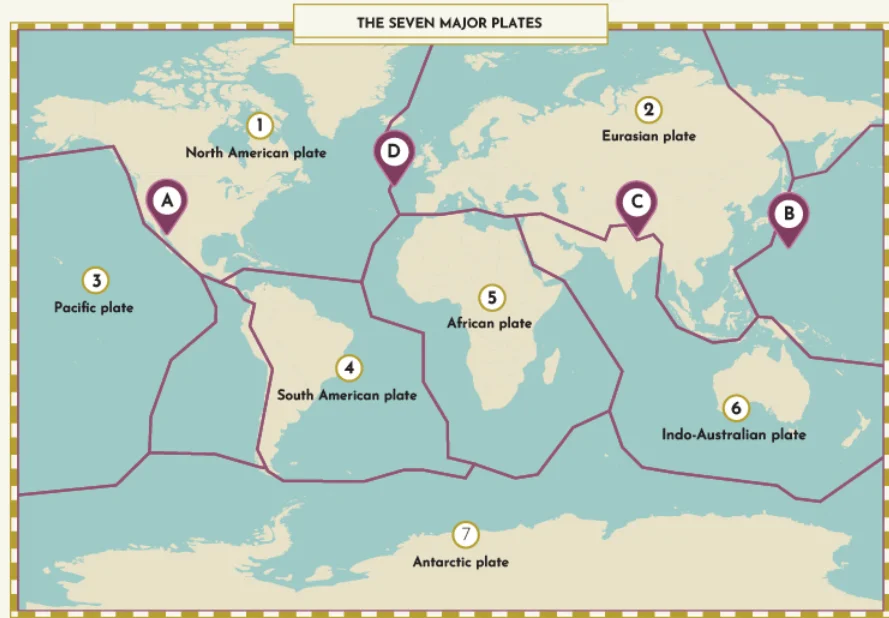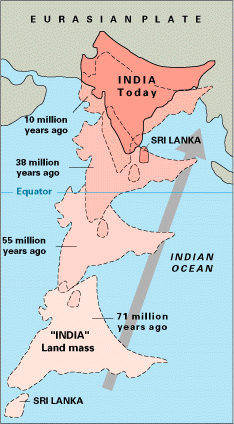Introduction: Geological Insights of Indian Plate
Sea floor spreading and plate tectonics revolutionized our understanding of Earth’s geology. They explain the creation and movement of oceanic crust, the division of Earth’s lithosphere into plates, and interactions at plate boundaries. The collision of the Indian Plate with the Asian Plate formed the Himalayas, highlighting the dynamic nature of our planet’s surface.
Concept of Seafloor Spreading: Earth’s Dynamics of Indian Plate
- Sea floor spreading is a process occurring at mid-ocean ridges.
- It involves the creation of new oceanic crust via volcanic activity.
- The newly formed crust gradually moves away from the ridge.
- This process plays a crucial role in explaining continental drift within plate tectonics.
- It was first proposed by Hess in 1961.
- The theory suggests that continuous volcanic eruptions at oceanic ridge crests lead to the fracturing of existing oceanic crust.
- New lava fills in these fractures, pushing the oceanic crust apart and causing the sea floor to spread. The Indian Plate, a major tectonic plate, is also involved in this process, contributing to the movement and interaction of plates.
- The oceanic crust’s relatively young age supports this idea, and it does not cause the shrinking of other oceanic areas.
- Hess also hypothesized that the sinking of the ocean floor, driven by volcanic eruptions at ridges, occurs at oceanic trenches where the crust is consumed.

Plate Tectonics: A Simple Explanation
- Plate tectonics theory explains that the Earth’s outer shell is divided into multiple plates, which move atop the rocky layer above the core known as the mantle.
- McKenzie, Parker, and Morgan introduced the theory of plate tectonics in 1967.
- These plates are akin to a rigid outer shell in contrast to the more fluid mantle and are referred to as the lithosphere.
- The lithosphere is a massive, irregularly shaped solid rock slab.
- Plate movement occurs horizontally over the Asthenosphere, with oceanic plates averaging around 100 km in thickness and continental plates about 200 km.
- The Pacific plate is the largest oceanic plate, while the Eurasian plate is the largest continental plate, and the Indian Plate is another significant player in this dynamic system, contributing to the overall movement and interactions of tectonic plates on Earth.
Major Plates: Exploring Earth’s Major Plates
- Antarctica and the surrounding oceanic plate
- North American Plate
- South American Plate
- Pacific Plate
- India-Australia-New Zealand Plate
- African Plate
- Eurasian Plate (covering Eurasia and adjacent oceanic areas)

Minor Plates: Spotlight on Earth’s Minor Plates
- Cocos Plate: Situated between Central America and the Pacific Plate
- Nazca Plate: Located between South America and the Pacific Plate
- Arabian Plate: Primarily comprising the Saudi Arabian landmass
- Philippine Plate: Positioned between the Asiatic and Pacific Plates
- Caroline Plate: Situated between the Philippine and Indian Plates (North of New Guinea)
- Fuji Plate: Located to the northeast of Australia
These plates, including the Indian Plate, are in constant motion over geological time, challenging the earlier belief of a single supercontinent, Pangaea, proposed by Wegener. The positioning of the Indian subcontinent has been determined through the examination of rocks from the Nagpur region.
Types of Plate Boundaries: Understanding Indian Plate Boundaries
- Divergent Boundaries: The Birth of New Crust
- New crust forms as plates move apart, known as spreading sites.
- An iconic example is the Mid-Atlantic Ridge, where the American Plate(s) separates from the Eurasian and African Plates.

- Convergent Boundaries: The Forces Beneath Earth’s Surface
- Crust is destroyed as one plate descends beneath another, as seen in events like the Nepal earthquake.
- The sinking of a plate occurs at subduction zones, which can happen in three ways: between oceanic and continental plates, between two oceanic plates, and between two continental plates.
- Transform Boundaries: Plates in Motion
- Crust is neither created nor destroyed as plates slide horizontally past each other.
- Transform faults, often perpendicular to mid-oceanic ridges, characterize this boundary type.
- Differential plate movement results from uneven eruptions along the ridge, influenced by Earth’s rotation.
Movement of Indian Plate: From History to Himalayas
Rates of Plate Movement: Tracking Earth’s Pace
- Rates of plate movement are, including the Indian Plate, determined using magnetic field strips parallel to mid-oceanic ridges.
- The Arctic Ridge moves the slowest (less than 2.5 cm/yr), while the East Pacific Rise near Easter Island has the fastest rate (over 15 cm/yr).

Force for Plate Movement: Driving Forces of Plate Movement
- Initially, the prevailing belief was that the Earth was a static, solid body. However, concepts like sea floor spreading and plate tectonics have changed this perspective.
- The mobile rock beneath rigid plates, including the Indian Plate, moves in a circular pattern, driven by convection cells.
- Heat within the Earth originates from radioactive decay and residual heat.
- The movement of the hot, softened mantle beneath the plates propels the plates, a notion initially proposed by Arthur Holmes and further developed by Harry Hess in the context of seafloor spreading.
Plate Components: Geographical Features and Boundaries
- The Indian plate encompasses Peninsular India and portions of the Australian continent.
- Its northern plate boundary along the Himalayas is a continent-continent convergence, forming a subduction zone.
- To the east, it extends through the Rakinyoma Mountains of Myanmar toward an island arc along the Java Trench.
- On the eastern margin, there’s an oceanic ridge east of Australia in the southwestern Pacific, marking a spreading site.
- The western margin, including the Indian Plate, follows the Kirthar Mountains of Pakistan and extends along the Makrana coast, joining the spreading site from the Red Sea rift southeastward, through the Chagos Archipelago.
- The boundary between the Indian and Antarctic plates is characterized by an oceanic ridge (divergent boundary) running west to east, merging into a spreading site just south of New Zealand.

Historical Plate Position: A Journey Through Geological Time
- India, including the Indian Plate, was once a large island in a vast ocean, situated off the Australian coast.
- The Tethys Sea separated India from the Asian continent until approximately 225 million years ago.
- India began its northward journey about 200 million years ago, coinciding with the breakup of Pangaea.
- The collision between India and Asia occurred around 40-50 million years ago, resulting in the rapid uplift of the Himalayas.
Changing Geography: Shifting Landscapes
- Approximately 140 million years ago, including the Indian Plate, the subcontinent was positioned as far south as 50°S latitude.
- The Tethys Sea and the Tibetan block were closer to the Asian landmass, separating the two major plates.
- During the Indian plate’s movement toward the Asian plate, a significant event was the outpouring of lava, leading to the formation of the Deccan Traps, commencing about 60 million years ago and persisting for an extended period.
- The subcontinent gradually moved closer to the equator during this time.
- From 40 million years ago and onwards, the formation of the Himalayas took place.
- Scientists believe that this process is ongoing, and the height of the Himalayas continues to rise to the present day.

Prelims PYQ
- Which of the following phenomena might have influenced the evolution of organisms? (2014)
-
- Continental drift
- Glacial cycles
Select the correct answer using the code given below:
(a) 1 only
(b) 2 only
(c) Both 1 and 2
(d) Neither 1 nor 2
Ans: c
Mains PYQ
Q. What do you understand by the theory of ‘continental drift’? Discuss the prominent evidences in its support. (2013)

 GS Foundation
GS Foundation Crash Course
Crash Course Combo
Combo Optional Courses
Optional Courses Degree Program
Degree Program












